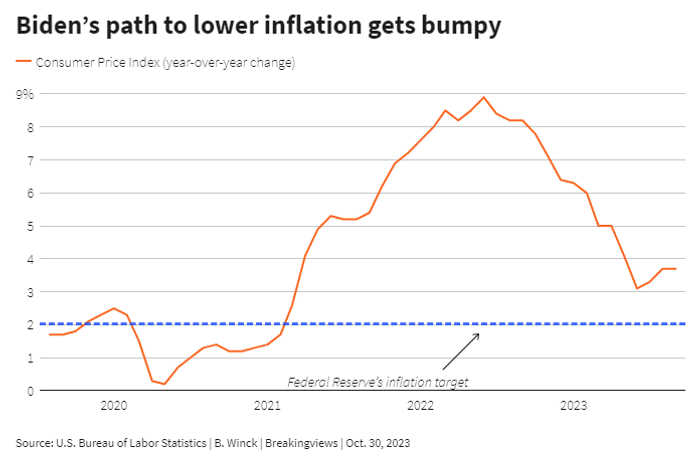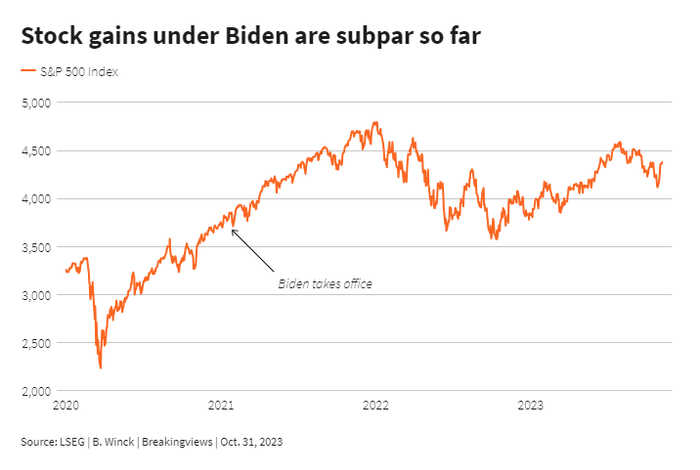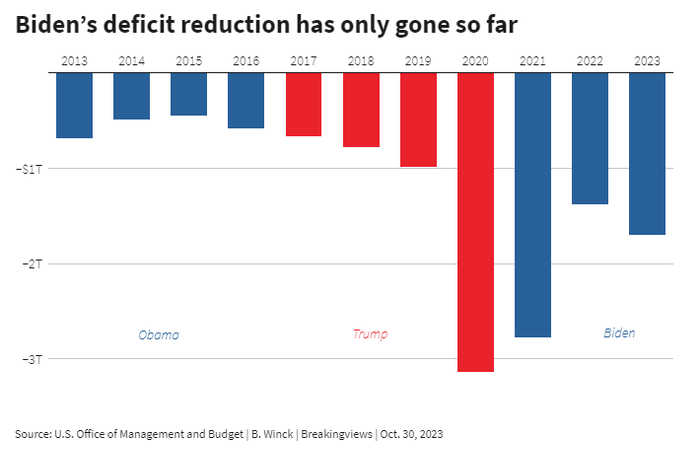Published 17:08 IST, November 10th 2023
Biden’s economic scorecard touts fragile advantage
Despite the White House touting the merits of “Bidenomics,” voters aren’t convinced.
Advertisement
Home field advantage. There are 362 days until the 2024 U.S. presidential election. And if the political strategist James Carville was right that “it’s the economy, stupid,” the next several months could make or break Joe Biden’s economic record. That, in turn, will shape his chances of winning reelection.
Despite the White House touting the merits of “Bidenomics,” voters aren’t convinced. More than 50% of households disapprove of the president’s handling of the economy, according to an October poll conducted by the Economist and YouGov. With Americans declaring the economy to be the most important issue for 112 weeks running, per Reuters and Ipsos polling, Breakingviews has tallied up a presumptive scorecard using 10 economic categories to gauge whether Biden’s record tips the scales towards him or his Republican rival in the 2024 election. As things stand, the current ruler of the free world touts a fragile advantage.
Advertisement
1. American Rescue Plan Act
The president’s first major piece of legislation passed in March 2021, injecting a $1.9 trillion stimulus into the U.S. economy. It included financial safety nets like payments of $1,400 to households earning up to $75,000, extended unemployment benefits, and an expansion to the child tax credit.
Collectively that cut overall poverty by 44%, according to the Brookings Institution, and lifted Americans’ financial health to new heights. Households’ disposable income after adjusting for inflation hit a record $20 trillion in the month that Biden’s measure was approved, according to the Bureau of Economic Analysis. Retailers from Walmart to Nordstrom credited the aid package with rebounding demand.
Advertisement
As those spending benefits have subsided, so has Americans’ favorable view of Biden’s leadership. Still, it’s a part of his record he can claim when the debates roll around.
VERDICT: Biden win
Advertisement
2. Infrastructure Investment and Jobs Act
Biden’s $1 trillion plan was the next major spending package to win congressional approval in November 2021. It fulfilled the president’s campaign-trail promise to refurbish the country’s roads and bridges, while expanding access to clean water and broadband internet. It will support an additional 600,000 new jobs by the end of next year and 800,000 jobs in 2025, according to Moody’s Analytics.
The bill is lifting a handful of American companies, including tractor maker Deere and construction equipment giant Caterpillar. Importantly, it wouldn’t have been able to pass without the help of 19 Republicans in the Senate and 13 in the House of Representatives, many of whom had sought to pass an infrastructure plan under Biden’s predecessor Donald Trump. The rare bipartisan win gives Biden a unique flex.
Advertisement
VERDICT: Biden win
3. CHIPS Act
The passage of the so-called “Chips and Science” plan allowed Biden to cement an industrial-policy legacy and fulfill a bipartisan desire to rely less on China’s semiconductor industry. More than 460 companies have shown interest in its $53 billion of research and production subsidies, the Commerce Department said last month. And the relationship between public and private investment is something to brag about. Micron Technology’s $100 billion outlay for a New York chip factory is expected to create nearly 50,000 jobs in the state. Intel’s $20 billion expansion in Arizona is expected to support 3,000 new jobs.
Republicans including Senate leader Mitch McConnell also played a crucial role in passing the bill, so it’s likely that both parties will tout their support on the campaign trail. But the value of showing successful bipartisanship will accrue to Biden.
VERDICT: Biden win
4. Inflation Reduction Act
The most recent of the president’s major spending bills is the one without any Republican support. It gave Biden a chance to revive progressive proposals before the 2022 midterm elections. Though the final plan was whittled down from $1.8 trillion to $430 billion of new spending, it still included Biden’s plans for clean energy tax credits and Medicare drug price negotiation. Bank of America estimates it has already spurred $132 billion of investment across more than 270 new clean energy projects.
Predominantly Republican-voting states are also winning some of the largest rewards. Texas was allocated $67 billion for clean energy production. West Virginia, the state most reliant on coal for its energy, has approved roughly $400 million in awards for wind, solar and clean battery projects. That makes the bill harder for Republicans to criticize.
VERDICT: Biden win
5. Labor market
Americans aged 25 to 54 are working at the highest rate in two decades, and Biden has deemed himself the most “pro-union president” in U.S. history. The moniker is likely to pay off. Two-thirds of Americans approve of unions, according to Gallup, marking the greatest popularity since the labor movement’s heyday in the 1960s.
The rosy record may sour in the next 12 months, though. Job creation has broadly slowed over the past year as high borrowing costs prompt businesses to slow growth plans. The Federal Reserve expects unemployment to climb to 4.1% from 3.8% next year, suggesting some 500,000 people may lose their jobs. The president’s pro-union stance could also backfire, too. The 40-day United Auto Workers strike likely weakened the economy’s growth, according to consulting firm RSM.
Still, Biden is ahead on jobs for now.
VERDICT: Biden win
6. Housing
The president has taken some action to shore up the supply of U.S. homes, from increasing investment in manufactured homes to reducing barriers to residential zoning. But while the administration says its actions have helped build “tens of thousands of affordable housing units,” the country is still short some 6.5 million homes, Realtor.com said in a March report.
Congressional Republicans haven’t taken much action, either. Various legislative proposals, like allowing home construction on federally owned land, haven’t moved forward. All the while, mortgage rates have reached the highest levels since 2000 and home construction has slumped.
VERDICT: It’s a draw
7. Inflation
All that federal spending has pushed up prices. Rapid inflation is likely the single biggest reason households feel pessimistic about the economy. It has forced the Fed to jack up interest rates at a historic pace to try to combat inflation.
And while inflation has come down to a 3.7% annual rate in September from the peak of 9% in June 2022, the recovery is far from over. The financial pain caused by higher prices, and any subsequent economic slowdown caused by higher rates, will leave a mark on voters.
VERDICT: Biden loss

8. Student loans
Forgiving swaths of student debt was another of Biden’s campaign promises, but his efforts have so far failed. The Supreme Court in June blocked the president’s plan to erase $430 billion of student debt through an executive order, upsetting the 26 million borrowers who had applied for relief. The president has forgiven about $127 billion of debt through smaller action, largely by updating federal aid programs. Yet that pales in comparison to the $1.8 trillion of student loans outstanding.
VERDICT: Biden loss
9. Wall Street
The S&P 500 Index is up 8% so far in Biden’s first term. That may look like a decent performance given high inflation and rising interest rates. But the bucket of leading U.S. stocks has returned an average 10% every year since it grew to include 500 companies in 1957. The benchmark is also down nearly 10% from its Biden-era peak in January 2022.
The picture in the bond market is worse. U.S. Treasuries are poised for their worst three-year rout since the country declared independence in 1776. Concerns around the government’s ballooning debt, rising interest costs and congressional dysfunction have driven yields to 16-year highs. All told, investors have plenty to complain about.
VERDICT: Biden loss

10. Deficit and debt costs
Biden’s wins on stimulus, infrastructure and clean energy came with a large price tag. The federal government’s debt pile has grown by more than $5 trillion during the president’s first term. The debt was a historically elevated 119% of GDP at the end of 2022.
While Biden has enacted some new taxes, like levies on stock buybacks, to shrink the budget shortfall, each of the president’s three years in office has seen deficits at least 40% larger than before the pandemic. And with higher interest rates making debt service more expensive, Biden’s spending could come back to bite him on election day.
VERDICT: Biden loss

Twelve months can be an eternity in economics. Housing and jobs give Biden the best opportunity to prevail over his Republican opponent. Yet inflation, jittery markets, high interest rates and elevated government spending still bring a great deal of uncertainty to the campaign trail. Our economic scorecard gives Biden a narrow lead. Now, though, he’s in a race against time.
Context News
U.S. President Joe Biden has touted the merits of “Bidenomics” throughout 2023 as he gears up for his reelection campaign. The president’s first term has seen unemployment fall to a historically low 3.4% while inflation steadily eased. Conservative opponents, including former president and 2024 frontrunner Donald Trump, have criticized Biden’s messaging and blamed his spending packages for peak inflation of 9% in June 2022.
Author: Ben Winck
17:08 IST, November 10th 2023
